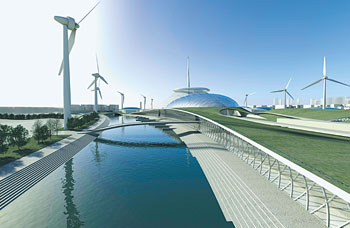
The project designed by Kazgor Design Academy LLP is the only Kazakh company among the group of finalists.
ASTANA – American firm Adrian Smith + Gordon Gill Architects are the frontrunners among the 10 finalists announced Aug. 26 in the competition to design the pavilions for EXPO 2017 to be held in Astana, said Aidar Marat, senior architect at the Astana EXPO 2017 Company and a member of the technical council advising the jury making the selection process.
The 10 finalists are Miguel Saraiva & Associados; UNStudio; Isozaki, Aoki & Associates Co., Ltd. of Japan; Manfredi Nicoletti of Italy; Vasconi Associates of France; Uberbau Saad & Stellmach Gbr; Officio Architettura Di Bertolini, Prodi Ec. Architetti Associati; GMP International Gmbh; Adrian Smith + Gordon Gill Architects and Kazgor Design Academy LLP, the only Kazakh company among the bunch. Manfredi Nicoletti already has work on display in Astana, having designed the Kazakhstan Concert Hall.
The finalists have in common “deep research and sustainability,” Marat told The Astana Times. “That’s the basis [of the finalist list]. You can see some of the projects are not that beautiful. But they have strong sustainability.” Sustainability, the use of alternative energy sources and heat and water conservation are important considerations for the future energy-themed expo.
The technical council looked closely at issues of visitor flow, adherence to third industrial revolution principles, post-expo conversion and, now just over three years away from the expo, feasibility.
“This is very difficult, you know. On the one side there’s beauty and the technical parts and on the other side durability and execution. We don’t have that much time, as you can see from our website; the countdown is clicking. We actually have to make it real,” Marat said. He commented that some projects were found to be simply not feasible in the time frame, including projects incorporating large domes and highrises.
 In terms of feasibility, Adrian Smith + Gordon Gill Architects look to be quite successful. “They have everything – they have deep research; TIR, third industrial revolution; post-expo, an architectural point of view … They took into consideration the local climate,” Marat said. Other favourites included Vasconi Associates; Isozaki, Aoki & Associates and GMP International.
In terms of feasibility, Adrian Smith + Gordon Gill Architects look to be quite successful. “They have everything – they have deep research; TIR, third industrial revolution; post-expo, an architectural point of view … They took into consideration the local climate,” Marat said. Other favourites included Vasconi Associates; Isozaki, Aoki & Associates and GMP International.
“Isozaki [Isozaki, Aoki & Associates] and Nicoletti [Manfredi Nicoletti], they covered the whole 25 hectares (61.7 acres). It’s good, but its expensive to cover the whole place. These guys [Gill], they’re covering but separately, so it’s a little bit cheaper and more achievable.” Adrian Smith + Gordon Gill Architects’ design houses the main pavilions in a circular area that contains discrete covered buildings around a large central structure.
Though the possibility of incorporating elements from different designs into the final expo plan has existed from the beginning, Marat does not think any elements from non-finalist designs will be used. And while the final design may be modified, he says the only changes made will be crucial ones, as any change will delay an already-tight schedule.
The ten finalists were chosen from the 46 design companies from 20 countries that presented their ideas at the Korme Exhibition Hall earlier this month. The final design will be announced on Sept. 1.


